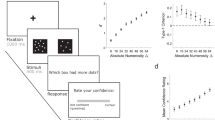Abstract
Decision-making processes of psychiatric inpatients were assessed at admission and prior to discharge, and compared to hospital staff members using a paired comparison paradigm in which subjects chose between hypothetical antipsychotic medications. Multidimensional analyses of binary choice matrices revealed that all subjects based decisions on the risks and benefits of medication, and weighted risks and benefits in roughly equal proportions. Hospital staff demonstrated greater internal consistency in their decisions than the inpatient sample at both time points. For newly admitted inpatients, severity of psychiatric symptoms and nonverbal intelligence were related to internal consistency of decision making, and behavioral indices of medication compliance predicted relative weighting of risks and benefits. For predischarge and comparison samples, verbal intelligence and treatment preferences predicted both outcome measures. Reliance on verbal reports of decision making may be misleading when assessing competence in acutely impaired psychiatric patients.
Similar content being viewed by others
References
Abelson, R. P., & Levi, A. (1985). Decision making and decision theory. In G. Lands & E. Aronson (Eds.),The handbook of social psychology (3rd ed., pp. 231–309). New York: Random House.
American Psychiatric Association (1987).Diagnostic and statistical manual of mental disorders (3rd ed., revised). Washington DC: Author.
Appelbaum, P. S., & Grisso, T. (1988). Assessing patients' competence to consent to treatment.New England Journal of Medicine, 319(25), 1635–1638.
Appelbaum, P. S., Lidz, C. W., & Meisel, A. (1987).Informed consent: Legal theory and clinical practice. New York: Oxford.
Arabie, P., Carroll, J. D., & DeSarbo, W. S. (1987).Three-way scaling and clustering. Beverly Hills, CA: Sage.
Brooker, B. H., & Cyr, J. J. (1986). Tables for clinicians to use to convert WAIS-R short forms.Journal of Clinical Psychology, 42(6), 982–986.
Cyr, J. J., & Brooker, B. H. (1984). Use of appropriate formulas for selecting WAIS-R short forms.Journal of Consulting and Clinical Psychology, 52(5), 903–905.
DeSarbo, W. S., Oliver, R. L., & DeSoete, G. (1986) A probabilistic multidimensional scaling vector model.Applied Psychological Measurement, 10(1), 79–98.
Faden, R. R., & Beauchamp, T. L. (1986).A history and theory of informed consent. New York: Oxford.
Grisso, T., & Appelbaum, P. S. (1989).Measuring understanding of disclosure (MUD)—Schizophrenia Version. Unpublished manuscript.
Grisso, T., & Appelbaum, P. S. (1990).Measure of Rational Thinking (RT)—Schizophrenia Version. Unpublished manuscript.
Grisso, T., & Appelbaum, P. S. (1991). Mentally ill and non-mentally-ill patients' abilities to understand informed consent disclosures for medication: Preliminary data.Law and Human Behavior, 15(4), 377–388.
Hedlund, J. L., & Vieweg, B. W. (1980). The brief psychiatric rating scale (BPRS): A comprehensive review.Journal of Operational Psychiatry, 11(1), 48–65.
Huck, S. W., & McLean, R. A. (1975). Using a repeated measures ANOVA to analyze data from a pretest-posttest design: A potentially confusing task.Psychological Bulletin, 82(4), 511–518.
Janis, I., & Mann, L. (1977).Decision making: A psychological analysis of conflict, choice, and commitment. New York: Free Press.
Janofsky, J. S., McCarthy, R. J., & Folstein, M. F. (1992). The Hopkins competency assessment Test: A brief method for evaluating patients' capacity to give informed consent.Hospital and Community Psychiatry, 43(2), 132–136.
Lidz, C. W., Meisel, A., Zerubavel, E., Carter, M., Sestak, R. M., & Roth, L. H. (1984).Informed consent: A study of decision making in psychiatry. New York: Guilford.
Loehlin, J. C. (1987).Latent variable models: An introduction to factor, path, and structural analysis. Hillsdale, NJ: Lawrence Erlbaum Associates.
Nisbett, R. E., & Wilson, T. D. (1977). Telling more than we can know: Verbal reports on mental processes.Psychological Review, 84(3), 231–259.
Overall, J. E., & Gorham, D. R. (1962). The brief psychiatric rating scale.Psychological Reports, 10, 799–812.
President's Commission for the Study of Ethical Problems in Medicine and Biomedical Research (1982).Making health care decisions. Washington DC: U.S. Government Printing Office.
Rosenfeld, B., & Turkheimer, E. (In press). Multidimensional representation of decision-making in chronic schizophrenics.Multivariate Behavioral Research.
Rosenfeld, B., Turkheimer, E., & Gardner, W. (1992). Decision making in a schizophrenic population.Law and Human Behavior, 16(6), 651–662.
Roth, L. H., Meisel, A., & Lidz, C. W. (1977). Tests of competency to consent to treatment.American Journal of Psychiatry,134(3), 279–284.
Shrout, P. E., & Fleiss, J. L. (1979). Intraclass correlations: Uses in assessing rater reliability.Psychological Bulletin, 86(2), 420–428.
Wechsler, D. (1981).Manual for the Wechsler Adult Intelligence Scale (revised). New York: Psychological Corporation.
Willet, J. B. (1988–1989). Questions and answers in the measurement of change.Review of Research in Education, 15, 345–422.
Author information
Authors and Affiliations
Additional information
This research was supported by the Program of Research on Mental Health and the Law of the John D. and Catherine T. MacArthur Foundation. The authors would also like to express their appreciation to Wayne DeSarbo for providing the MDS program used in these analyses, Jim Pisano, for assisting in the development of the paired comparison computer program, Tom Grisso and Paul Appelbaum, for providing their then unpublished measures of decision making (UTD and TRAT), and the staff and patients of Western State Hospital for participating in and assisting in the completion of this research.
About this article
Cite this article
Rosenfeld, B.D., Turkheimer, E.N. Modeling psychiatric patients' treatment decision making. Law Hum Behav 19, 389–405 (1995). https://doi.org/10.1007/BF01499139
Issue Date:
DOI: https://doi.org/10.1007/BF01499139




